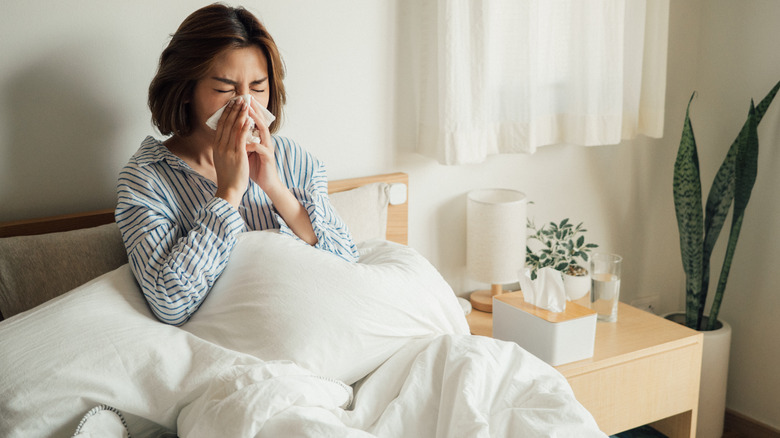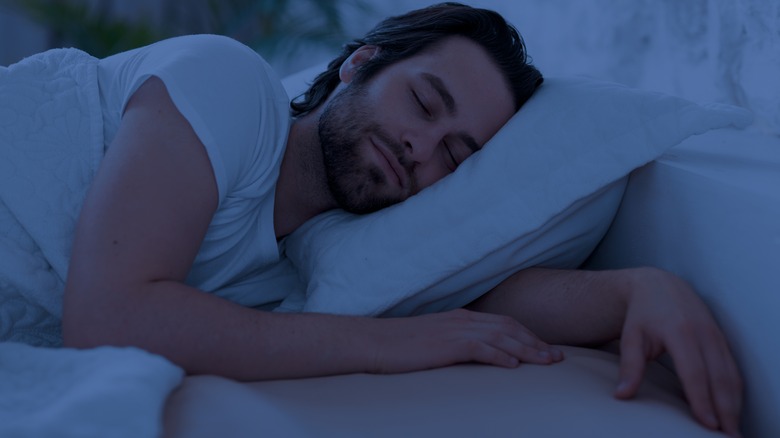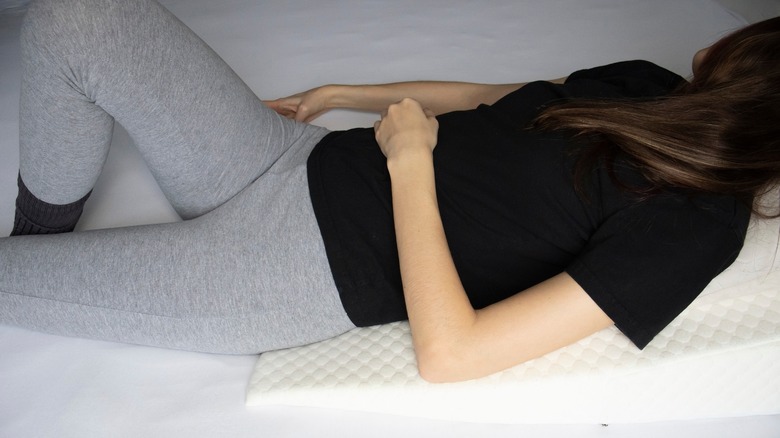The Best Sleep Position If You Have A Stuffy Nose
Sleep is an important part of healing when a yucky cold has knocked you off your feet. Ironically, however, sleep can be one of the most challenging parts of recovering from sickness. This can be particularly true when dealing with nasal symptoms like stubborn congestion or post-nasal drip.
Dr. Ofer Jacobowitz, co-director of Sleep, ENT and Allergy Associates, tells Sleepopolis that when our breathing is obstructed by a stuffy nose, we experience nearly ten times more micro-awakenings than we normally do. Stuffiness from post-nasal drip can also cause sleep disruptions. When we climb into bed, we're no longer upright. As a result, this causes mucus to flow from the nose into our upper respiratory airway, which can have us coughing all night long (via Chacko Allergy, Asthma and Sinus Center).
Unfortunately, a bad night's sleep can be a nightmare, leaving us feeling tired, unfocused, and run-down the next day. If you find that you're struggling with sleep while enduring the misery of a stuffy nose, here's how you can position your body as you snooze to potentially provide some welcome relief.
Stick with side-sleeping and remember to elevate your head
Side-sleeping is going to be your best bet when you're feeling stuffed up, as doing so will help reroute blood flow from one nostril to the other and provide at least a little one-sided relief. "When you lie with one side down, the dependent (down side) fills with blood, while the up side will decongest or shrink," Dr. Christie Barnes, residency program director of the Department of Otolaryngology—Head and Neck Surgery at the University of Nebraska Medical Center, told Sleepopolis. "This makes up the majority of reasons why people can't breathe at night and have to flip over to breathe better."
While flip-flopping back and forth all night may not sound like the most ideal solution, it certainly beats the discomfort of post-nasal drip when lying completely horizontal on your back. If you're a devoted back-sleeper, however, be sure to elevate your head and neck. Not too much, though: Sleepeezee cautions that having your head at too high an angle can force your head to droop over your airways and further hinder breathing ability. Not to mention, you may wake up with a painful ache in your neck or shoulders the following morning.
This is how high your should elevate your head when you have a stuffy nose
Depending on your sleeping position, the recommended elevation of your pillow will be different. If snoozing on your side, you'll want to choose a wedge pillow at a lower angle (via Sleepopolis). If you prefer to sleep on your back, many opt for a wedge pillow between 7 inches and 12 inches high. If you're without a wedge pillow, Sleepeezee suggests using your regular pillows as long as you don't pile them one on top of the other. Instead, arrange them in the shape of a triangle underneath your head and neck for even support.
In addition to positioning your body for optimal sleep, there are a number of other treatment methods one can implement to help alleviate symptoms of the common cold. For example, expose yourself to steam from a hot shower to help open up nasal passages prior to sleep. For dinner, stick to a bowl of warm chicken noodle soup to help break up mucus. When it comes time to turn out the lights, keep the house at a cooler temperature between 68 degrees and approximately 71 degrees Fahrenheit. Cranking up the heat, while toasty, may exacerbate cold and flu symptoms. Finally, instead of harshly blowing your nose, gently blot your nostrils with a tissue if you feel yourself getting a little sniffly during the course of the night.



